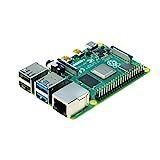
Patrick Campanale has been in the tech space for well over a decade, specializing in PC/gaming news and reviews, as well as maker-focused products to build small businesses.
With a start in technology back in 2010 surrounding the Palm/webOS ecosystem, Patrick spent his formative years developing mobile applications as well as blogging for various publications, eventually leading to starting his own website in 2014. After running a technology blog for a few years, he stepped out of that role and into the world of high-end custom PC manufacturing and building, with a focus on YouTube video production and overclocking. Then, six years ago, Patrick joined the 9to5Toys team as an editor/writer/reviewer with over 14,000 articles being published there there, ranging from deals and roundups to in-depth reviews on the latest technology, video games, 3D printers, and more.
In his free time, Patrick loves to create projects from wood using various robots and methods, including leveraging the technologies of CNCs and lasers. If Patrick isn’t working on a computer or playing video games, he’s likely in his 2-car garage workshop creating something unique. In addition to all this, Patrick is also a youth pastor at his local church where he feels God has called him to serve, and he loves every minute of it.
Jump Links
-
Keep Up With Your Pi’s Stats With This Unique Raspberry Pi Dashboard
- Advertisement -
-
Turn Your Old Pi and Monitor Into an Always-On Clock and Weather Station
-
Ditch Facebook and Self-Host Your Own Personal Blog
Are you looking for a fun weekend project with your Raspberry Pi? I recently picked up a few extra Pis for my homelab, and instantly started spinning up new things just for the fun of it. Here are three projects that you can have up and running before Monday arrives.

Raspberry Pi 4 Model B
- Brand
-
Raspberry Pi
- CPU
-
Cortex-A72 (ARM v8)
With the Raspberry Pi 4 Model B, you can create all kinds of fun projects, and upgrade gadgets around your home. Alternatively, install a full desktop OS and use it like a regular computer.
Keep Up With Your Pi’s Stats With This Unique Raspberry Pi Dashboard

Whether you have one Raspberry Pi or many, knowing what your system stats are can be vitally important. I just picked up a few extra Pis for various projects around my house, and I have three of them in a little mini rack that I 3D printed. This means that temperature could become an issue, and monitoring various parts of the system is more important than ever.
That’s where the Raspberry Pi Dashboard comes in. This simple PHP dashboard gives you all the information you could want about your Pi. At a glance, you’ll be able to see things like uptime, CPU temperature, RAM and CPU usage, available storage, and even have power toggles at your fingertips.
Deploying this is actually pretty straightforward. All it requires is some type of web server (apache, nginx, lighttpd) and PHP installed on your system. If you’re looking for a quick way to get up and going, here’s the command I ran to deploy the Raspberry Pi Dashboard.
sudo apt update && sudo apt install apache2 php libapache2-mod-php -y
This will install apache2, PHP, and the required libraries to link PHP and apache2. From there, you can follow the default instructions in the GitHub project’s readme. In total, it took about five minutes to deploy the dashboard, and now I can easily keep tabs on all my Raspberry Pis at a quick glance.
Turn Your Old Pi and Monitor Into an Always-On Clock and Weather Station

While I don’t have a spare monitor (right now), I’m still thinking about finding a way to use Astronomy/Weather Clock. Designed to give you a straightforward clock and weather display, aw-clock (what the project goes by for short) is quite versatile and robust. You’re able to add things like a GPS hat to your Pi and even physical temperature or humidity sensors.
The installation procedure for aw-clock is a bit more complicated than the Raspberry Pi Dashboard. The Astronomy/Weather Clock project is only available on GitHub, and you’ll start by cloning it to your system. Then, you can begin the build process. I had to do a few modifications to my system to get it to build, as chromium-browser is no longer available (and the project is just chromium now). I got past that with a simple command:
sudo apt update && sudo install chromium && sudo ln -s /usr/bin/chromium /usr/bin/chromium-browser
This command installs Chromium, then links the Chromium binary to the Chromium-browser file, which allows aw-clock to finish building. I ran into one final issue at the end of the build script, where it wouldn’t launch because I don’t have any desktop management software installed, as I run my Pi’s headless.
However, I was easily able to navigate to the Pi’s IP and port that I set up at the start of the build script and see aw-clock just fine. It’s actually nice that it works this way, as you could pull up the feed on any computer around your house. In fact, you could even have one Pi host the aw-clock server and then access it from other low-power Pis (like the Pi Zero 2 W) stationed around your house or business.
Ditch Facebook and Self-Host Your Own Personal Blog

I’ve covered hosting blogs in various capacities several times, but none of the traditional platforms really focus on ditching Facebook for a more centralized approach. That’s where Haven comes in. Designed to be a private blog for you to write and for friends to view, Haven is definitely a unique platform.
While you can choose to have Haven host your blog, you can also easily spin it up in Docker. As I use Portainer, I had to generate my own Docker Compose file for it, but if you use Docker-CLI then everything can happen in-terminal.
Once up and running, Haven is pretty straightforward. It’s designed as a private-first blog, meaning all users have to log in to see what you’ve written. Think of this as the same barrier as adding a friend on Facebook. You can either give people their own logins or just have one “friends” login here.
Haven works with Markdown, meaning you can write all of your posts in Markdown and then post straight to Haven. It also supports image uploading, which is a really nice feature.
These are just a few fun projects to spin up on your Raspberry Pi this weekend. If you’ve already got a dashboard, clock, or microblog running on your Pi, then there are plenty of other things to try!
You could turn your Pi into a game streaming client or even build a smart mirror. One thing I really want to try one day is building a retro tabletop arcade with a spare Pi. The possibilities are endless, so go grab your Pi and start tinkering!



